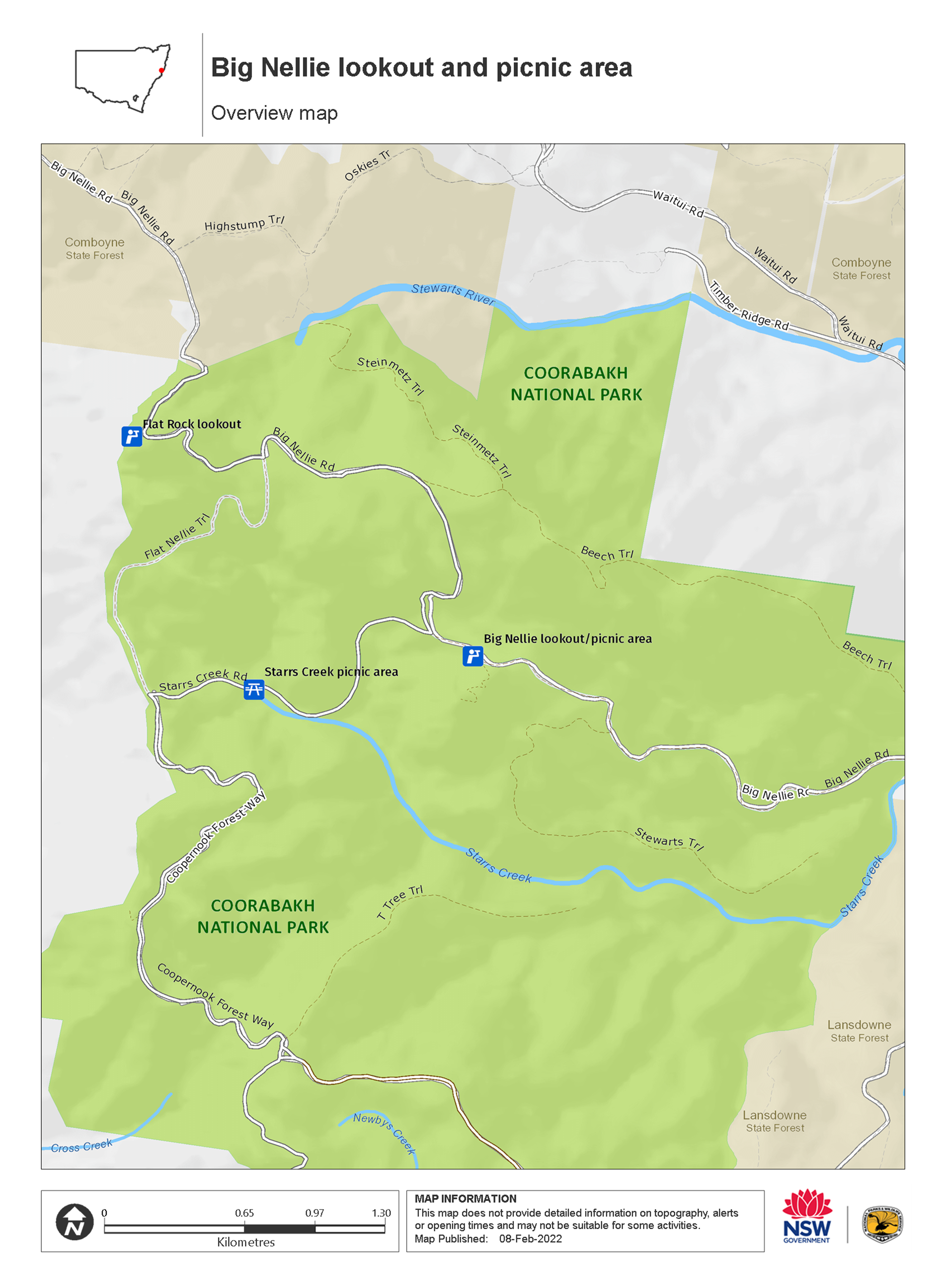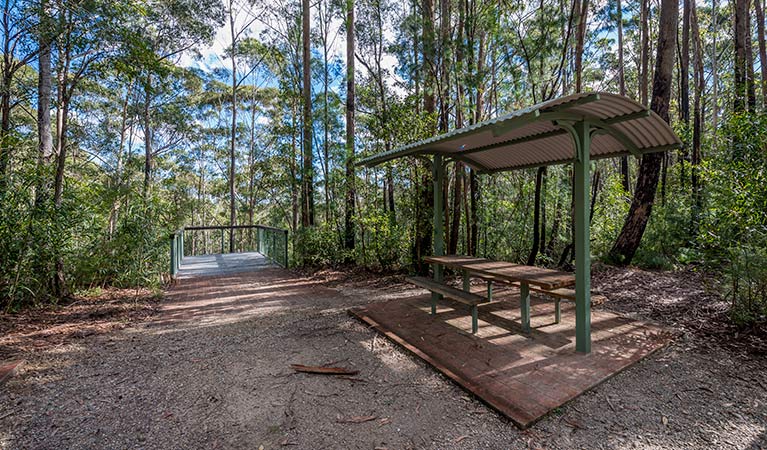Overview
Big Nellie, in Coorabakh National Park, and the scenic lookout at its base offers a vantage point for photography and birdwatching, as well as a great place to picnic.
- Type
- Lookouts
- Where
- Coorabakh National Park in North Coast
- Accessibility
- Medium
- Opening times
Big Nellie lookout and picnic area is always open but may have to close at times due to flood events, poor weather or fire danger.
- What to
bring - Hat, sunscreen, drinking water
Big Nellie is one of the main attractions of Coorabakh National Park. It’s an imposing rock plug that soars more than 500m above sea level, reminding visitors of an earlier time when the Australian landscape was still being created by volcanoes and earthquakes.
The best place to see scenic Big Nellie is right near its base, where a handy platform has been built to give clear views over the rocky hump. Take the opportunity of a great backdrop to do some family photography, or if you’re keen on birdwatching, this is a great place to spot some of the local birdlife.
Right near the lookout are several tables, making this a good choice as a place to picnic as well. Take advantage of the lookout and then settle down to a leisurely lunch, or consider Starrs Creek picnic area for a shadier alternative in the lush rainforest.
Map

Map legend

Local alerts
For the latest updates on fires, closures and other alerts in this area, see https://www.nationalparks.nsw.gov.au/things-to-do/lookouts/big-nellie-lookout-and-picnic-area/local-alerts
General enquiries
- National Parks Contact Centre
- 7am to 7pm daily
- 1300 072 757 (13000 PARKS) for the cost of a local call within Australia excluding mobiles
- parks.info@environment.nsw.gov.au
Park info
- in Coorabakh National Park in the North Coast region
Coorabakh National Park is always open but may have to close at times due to poor weather or fire danger.
Visitor info
All the practical information you need to know about the Big Nellie lookout and picnic area.
Getting there and parking
Big Nellie lookout and picnic area is in the northern precinct of Coorabakh National Park. To get there:
- From Coopernook and Moorland, take Forest Drive Road north.
- Travel through Coopernook State Forest and follow the signs to Coorabakh National Park
- Turn left at Newbys Creek Road, and follow signs via Starrs Creek to Big Nellie lookout and picnic area.
Road quality
Check the weather before you set out as the road to Big Nellie lookout and picnic area can become boggy when it rains.
- Unsealed roads
Vehicle access
- 2WD vehicles (no long vehicle access)
Weather restrictions
- 4WD required in wet weather
Parking
There's a gravel carpark at the lookout and picnic area with 3 car spaces and 1 accessible parking spot.
Best times to visit
There are lots of great things waiting for you in Coorabakh National Park. Here are some of the highlights.
Spring
Several endangered plants flower in the park, creating beautiful displays of wildflowers near lookouts and along roadsides.
Summer
A perfect escape from the summer heat can be found in the subtropical rainforest around Starrs Creek, with its elevated boardwalk, and along the slightly more adventurous path to the cave at Newbys Creek.
Winter
Low rainfall and reasonable temperatures make winter a great time to take advantage of the several stunning lookouts around the park.
Weather, temperature and rainfall
Summer temperature
Average
17.2°C and 28.6°C
Highest recorded
45.2°C
Winter temperature
Average
6.5°C and 12.8°C
Lowest recorded
-5°C
Rainfall
Wettest month
March
Driest month
September
The area’s highest recorded rainfall in one day
280.2mm
Facilities
Drinking water is limited or not available in this area, so it’s a good idea to bring your own.
Picnic tables
There's an accessible picnic shelter towards the end of the path that leads to the lookout platform. The shelter is set on a paved slab.
Carpark
There is a small carpark near the lookout.
Step-free access
The lookout and picnic area is mostly flat and step-free, with a hard-packed ground path that leads to the lookout platform. The path has wooden handrails on either side.
- Step-free outdoor pathways
Maps and downloads
Accessibility
Disability access level - medium
- The lookout and picnic area is mostly flat and there's step-free access along a pathway. The pathway has wooden handrails on either side.
- There's an accessible picnic shelter at the end of the path that leads to the lookout
- There's a gravel carpark at the lookout with 1 accessible parking space
Prohibited
Pets
Pets and domestic animals (other than certified assistance animals) are not permitted. Find out which regional parks allow dog walking and see the pets in parks policy for more information.
Smoking
NSW national parks are no smoking areas.
Learn more
Big Nellie lookout and picnic area is in Coorabakh National Park. Here are just some of the reasons why this park is special:
A legacy of timber harvesting

Before it was a national park, Coorabakh had a long history of forestry operations. This was once a centre of intensive logging - particularly during the World Wars - and visitors can still find physical remnants of the industry. One evocative site is the Langley Vale tramway, which was originally used to transport timber 21km from Old North Camp to Langley Vale, first by horse and later by steam engine. The line was abandoned in the 1940s, but relics still remain: timber bridges, elevated platforms, offcuts left to moulder in the forest, reclaimed by nature.
Eighteen forest ecosystems

The astonishing variety of forest ecosystems in Coorabakh vary from wet foothills covered in blackbutts to subtropical rainforest. This makes a visit a fascinating experience as you range from high lookouts over eucalyptus canopies to cool mossy creekbeds.
- Big Nellie lookout and picnic area Big Nellie, in Coorabakh National Park, and the scenic lookout at its base offers a vantage point for photography and birdwatching, as well as a great place to picnic.
- Flat Rock lookout Flat Rock lookout offers scenic views over the Coxcomb, Goonook and Killabakh nature reserves, as well as great picnicking and birdwatching opportunities.
- Newbys lookout Newbys lookout, on the edge of the Landsdowne escarpment, offers scenic views over Manning Valley as well as opportunities for birdwatching and picnicking.
Home to rare native species

The park is important at a regional level for a number of rare and significant plant species. There are also several species of threatened animal, including the spotted-tailed quoll, yellow-bellied glider, powerful owl and stuttering frog. Don’t forget your camera.
- Newbys Creek walk and caves A short walk along Newbys Creek in Coorabakh National Park takes visitors to a scenic cave, where a large overhanging rock creates a natural shelter above the stream.
- Starrs Creek picnic area Great for picnicking and birdwatching, Starrs Creek picnic area in Coorabakh National Park also offers an elevated boardwalk that opens up the rainforest on an easy walk.
The Aboriginal connection

Before Europeans arrived, the area was the traditional domain of the Ngaamba People. Research suggests that they once used the dramatic cliff lines and distinctive volcanic formations to navigate the region. They may also have been important for cultural practices, sites of sacred ceremonies and other social gatherings.

